“One defining aspect of entrepreneurship is the presence of risks at every turn. It is crucial to embrace these challenges without fear or hesitation, and instead, be prepared to venture into uncharted territories, learn from experiences, and adapt to navigate the highly competitive world we live in.”
Snehal Verma
Co-Founder and Director, NatureDots
Ph: 9205409981;
Email: reachus@naturedots.com
The CRISP team comprised of Bhuvana N, Sejal Agarwal, and Ditty Maria Dominic conducted an interview with a promising young aquapreneur with the aim of gaining insights into her groundbreaking startup, and to explore how digital technology is driving transformative changes in the freshwater and marine ecosystem while assisting nature and fish farmers. Let’s take a closer look at their insightful conversation.
|
NatureDots combines nature-based science with DeepTech tools for a climate-resilient, nature-positive economy. Their AquaNurch® System, an intelligent think machine, unravels the interconnections of complex ecosystems using technology and science. Beyond conventional approaches, NatureDots transforms aquaculture, promotes healthy fisheries, and restores ecosystem health through innovative solutions. |
Can you tell us about your background and career journey, from being a computer science engineer to your current role in water and coastal resource management?
I was born in Mumbai and fell in love with the amazing marine life of our coasts, I spent a lot of my time observing the tidal pools. But as my parents moved around different parts of India due to their jobs, I found myself always spending most of my time around waterbodies, observing the human-nature-water interactions. In hindsight I believe these early experiences shaped my interest and future trajectory.
As for my background, I am trained as a computer science engineer with a Master of Business Administration (MBA) and now a Master of Environmental Management (MEM) in Water and Coastal Resource Management from Duke University, North Carolina. My work experience has been in the renewable energy sector, non-profit management, and multilateral agencies; and I have delivered global projects in three countries. As an engineer-turned-forest manager-turned water innovator, the best way I can describe myself is that I have specialised in being a generalist. As I dabbled in multiple roles, I can now see a common theme running through it all, namely ‘impact-focussed work’.
Please share with us the concept behind AquaNurch and how it relates to your experiences and observations.
AquaNurch – as an idea and a concept – began with my journey as a student entrepreneur and innovator at the Indian Institute of Forest Management (IIFM). I chose to be with IIFM after leaving Xavier School of Management (XLRI), Jamshedpur, and Indian Institute of Management (IIM), Indore, because of the uniqueness of the Institute and the fact that it was surrounded by water on three sides. This made me choose it. I often spent much of my free time birding or watching the gharials and soft-shell turtles on the lake banks, from the safety of campus boundary walls. In 2018, for one of the class projects I chose to work on freshwater fish farmers’ issues/distress points in the Bhopal Upper and Lower Lake systems. What started as a class assignment turned into a two-year long deep-dive into understanding the complexity around our freshwater resources.
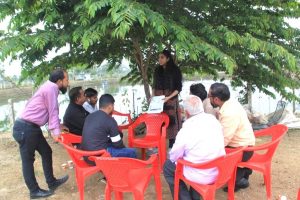 With commercial fisheries producers in Chhattisgarh
With commercial fisheries producers in Chhattisgarh
As my engagement continued with more frequent visits with my advisor (who is now an official advisor to NatureDots) I was able develop a trust-based bond with the local fishing community members. I still remember… it was 2018 December when I received a distress call from one of the fish farmer’s sons early in the morning requesting me to immediately visit the lake areas where they had stocked their fish. As I reached the location, I sensed the scale of destruction that had taken place the night before, the entire three tons of fish were dead and floating on the surface. At this point their entire stock of Indian major carp was ready for harvest; it must be remembered that farmers usually take loans to raise them. All of us were clueless as to what had gone wrong and why this destruction had happened. When we tried to find out what had happened overnight, they said that there were rains the previous night that resulted in water in the pond getting polluted with water from surrounding areas resulting in change of water chemistry in the pond. This was based on the farmer’s inputs. As a techie myself, my problem-solving mind immediately sprang into action and I got my friend, Ashish Kumar, (who is now the AI-Data Head at a multi-national company in Silicon Valley) involved in helping me design a simple system to capture the changes in water quality. That’s how we build the first minimum viable product (MVP) of AquaNurch.
On further engagement what we discovered was that many people who are engaged in fishing have usually migrated from different parts of India with a community knowledge of fishing, and they are largely landless labourers. Fishing is an additional source of income for their own sustenance. This event became a sort of starting point that led me to think seriously about AquaNurch. In other words, the idea of AquaNurch came from this problem that fish farmers face and the biodiversity in our freshwater bodies.
How did the journey start once you had your idea about AquaNurch?
As a student at IIFM, in one of the class projects I decided to work on the water ecosystem with special reference to pollution, and also with a passion to do something for society and particularly help fish farmers achieve a good source of livelihood. During the project period at IIFM, I met and discussed many things with Mohammad Aatish Khan, the cofounder of AquaNurch, who also had similar interests like mine on working with water resources. Being a computer science engineer by education, I viewed technology as a complement for creating a systemic solution for solving some of these water-related problems, which we were witnessing. The engineering and practical experiences together with the network from IIT and IIFM on water resource resulted in the founding of NatureDots gradually.
After studies at IIFM, to understand the water sector more, I joined World Wildlife Fund Inc. (WWF), where I worked on wetlands conservation, the new Ramsar’s notification and the Gangetic dolphin programme. In October 2019, I decided to quit the job at WWF, and take the project full-on to turn it into a start-up. Initially we were growing fishes in our own backyard and trying to test the water and fish life interaction. Once the codes worked and started to show significant results, I wanted to test it before taking it to fish farmers. Before COVID hit, we were in the field from October to December 2019 where we had 5-6 fish farmers with us who were ready to test our device. That’s how it sort of organically grew up.
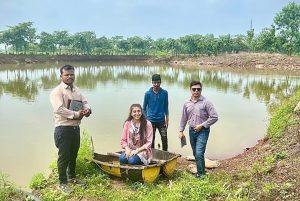 Nature Dot team at field work
Nature Dot team at field work
How did you identify and work with fish farmers?
Somewhere along the way we adopted and followed the innovation theory curve for identifying the farmers. Initially, one-on-one interaction with fish farmers helped us understand them and their culture and enabled us to lay the foundation for creating a strong bond of mutual trust. They were our first investors by providing their support by hosting us on fields, giving us their time and efforts on ground. We worked very closely with them and created our own ‘innovative fish farmers’ network which also included participation from women fish farmers.
What is NatureDots all about?
NatureDots got registered in August 2019 as a private limited company with two co-founders – Ms. Snehal Verma and Mohammad Aatish Khan – and started working as a full-fledged company from December 2019. It is a Nature-Tech + hard-tech start up dealing with water resource management, water pollution, etc., with the help of technology and focusses on how currently these resources are being managed to create better robust systems.
NatureDots’ product, AquaNurch® System (https://naturedots.com/product) is an intelligent systemic-based think machine which is unwrapping the interconnection of complex ecosystems by using the power of technology and science (to simplify and not to complicate). Given the complexities of the aquatic ecosystem, NatureDots’ team goes beyond the conventional approach of data analytics, water parameters monitoring using Internet of Things (IoT) and geo spatial analysis. With this system and solutions, we are transforming aquaculture-based food systems, ensuring healthy fisheries (food-security and protein security) and re-installing ecosystem health by assisting in restoration, conservation and protection.
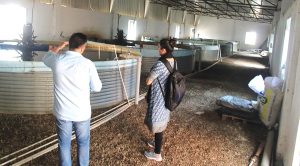 Field work with individual commercial fisheries producer
Field work with individual commercial fisheries producer
Can you elaborate on your prime product – AquaNurch System?
As said earlier, the AquaNurch Systems (https://naturedots.com/product) is a first of its kind deep-tech tool developed to provide solutions to the natural resource problems associated with water. The AquaNurch units acts as a Neural Node, capturing the pulse of water ecosystems from both the depth and the surface of water, combining it with the geospatial planetary spatial temporal data, and processes it using proprietary AI models. The system acts as a Biophysical Chemical Ecological Big Data Factory on the natural system where it is deployed providing localised, accurate, timely and simplified resource intelligence. Its data Application Programming Interface (APIs) are capable of providing primary onsite real-time data from 5-seconds to any defined interval. The team then leverages massive data and other information on ecosystem health to navigate and generate customised usable, beneficial insights for different customers and use-cases, providing a roster of services. Focussing on the freshwater aquaculture in India, we are delivering solutions in the form of alerts, advisories, and insights in 13 languages; globally in English via mobile and web dashboard.
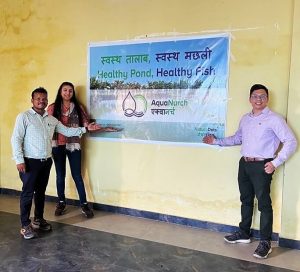 AquaNurch for healthy pond and healthy fish
AquaNurch for healthy pond and healthy fish
Is the data available on web dashboard as an open source?
Yes, that is the idea, to make it accessible to everyone in open source. AquaNurch’s data for different water assets is made available on request. As we are in the early stages of our enterprise, navigating complex AI and data compliance while being resource efficient always necessitates constant effort to maintain the right equilibrium. We charge nominal fees for our data assets which are essential to maintain the robust quality and security of our pipelines.
So, who are your primary clients?
Currently, we are working with fish farmers, water asset managers, restoration managers, etc., where products are customised according to their needs on a payment basis. We have an internal process and templates for customer identification and engagement. The product price depends on the kind of stakeholder (B2B, B2G) we are dealing with – government and commercial aqua-culturalists. We customise the product price depending upon their needs as well as duration of the engagement. Smallholder farmers are engaged indirectly through government or a business partner. Under National Rural Livelihood Mission (NRLM), we have partnered with Chhattisgarh State Rural Livelihood Mission (Bihan) as one of our government partners.
Though the company is based on digital innovation, what other digital innovations do you use?
We use a ‘Software as a Service’ (SaaS) platform and a mobile application that provides information to our clients as and when needed. We are also using internally developed AquaNurch as an AI-IoT device to derive data and use on our web-based platform, and mobile application to communicate the relevant advisory to our customer. Since these services are customized as per need, its cost is also derived accordingly.
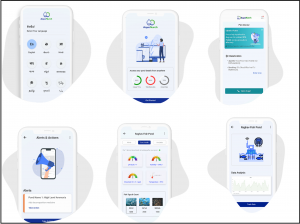 AquaNurch Mobile application for fish farmers
AquaNurch Mobile application for fish farmers
How did the idea of providing advisory services work?
The biggest challenge we found was that fisheries have high mortality rates. The risk behavior and the risk appetite of fish farmer is very different as compared to crop farmers or such. When they are doing fishery, as a thumb rule, they assume having a certain percentage of loss arising from mortality rates. If they put 100 fish, they know and are prepared to get only 70 fishes out of 100. But we know that these losses can be avoided through better management and availability of best sectoral practices and information.
Instead of bombarding the farmers with an overload of information, we worked very diligently in creating these advisories and insights that are specific to each species of fish in different states. We advise them on: what is the stocking cycle they should follow? How many fish should they stock? What kind of fertilization method to use? How much feed has to be added? etc. These advisories are provided mainly to minimize wastage to maintain the water quality. Our solution monitors the end-to-end fisheries cycle and is capable of forecasting five days in advance of any impending changes in water chemistry. For fisheries it is a matter of two to three hours where an entire stock can be wiped out! Thus, effective monitoring is super-critical.
Currently we engage with 1152 fish farmers and out of that 117 are women fish farmers. The technology enables them, especially women fish farmers, in optimising their operations and assist in managing their workload. With the use of our system, they can conveniently access the best industry and pond-operation insights and are not in a blind spot in case of any changing event, which may have a negative consequence on their productivity.
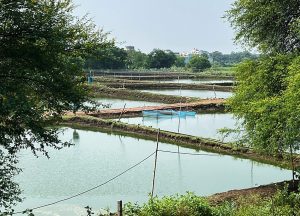 AquaNurch Fisheries Farms in Chhattisgarh
AquaNurch Fisheries Farms in Chhattisgarh
How comfortable are farmers in using digital tools?
They all have mobile phones and I think they are quite comfortable. The advent of Digital India and boom in Agtech has also had a trickle-down effect in other streams of rural economy. Almost every rural shopkeeper has a Paytm app and availability of cheaper and more resilient mobile phones have made things happen. Most of the fish farmers we met possessed a smart phone and it was not that difficult for them to adopt and use our app. For us, the ground became more fertile during COVID because everything was getting done online. Even if they didn’t like using cell phones, they had no other option and they had to rely on digital tools. The farmers who use digital tools are impressively vocal about its quality and convenience of use. It is evident that if it is not functioning well, they will not install or use it.
In what formats are these advisories generated?
It is in message form; alerts are notified by displaying in the AquaNurch app. We give a mix of mobile -notifications and customer calling to help them navigate and address any challenges.
Can you give me an idea of the reach of NatureDots?
Yes, we have around 3800 ha of natural water bodies under active management. 1500+ large farmers are under active engagement across Chhattisgarh, Maharashtra, Haryana and Andhra. In USA, we have 2000 ha under management.
What strategies did you employ to ensure a cautious and measured approach to scale up AquaNurch?
A strong customer connect and ensuring speedy, effective and high-quality solution delivery to our customers irrespective of their stage of fishery development and knowledge, ensured that we can create strong user sentiment for adopting our AquaNurch solution. We focus more on scaling up with quality, taking baby steps so that we can eventually deliver big. This has been largely possible as we haven’t taken any investment loan so far and are fully bootstrapped, having raised only non-dilutive funds.
 AquaNurch system Installation in the fields of USA
AquaNurch system Installation in the fields of USA
Are you collaborating with other stakeholders in the fisheries sector and if so, how?
In India the ponds are state controlled, put on tender by the government. By default, government becomes our partner, and we have to have clearances from them if you need to work on that particular water body. Private ponds, on the other hand, are obviously privately held – people dig their own ponds and it calls for a different approach to reach out to them. While assessing water bodies, stakeholder analysis and insights are super critical. So, we must triangulate and bring in all those stakeholders’ perspectives before taking the solution on ground. We collaborate and partner with different agencies working in the fisheries field because the opportunities are many but scale of the problem is huge as well, and no one organization or solution can singly resolve these challenges.
How are you enhancing your capacities as an entrepreneur?
I haven’t done any courses specially related to entrepreneurship. I have been talking to women entrepreneurs worldwide through various online platforms and received in-person guidance and mentoring from both women and men. Also, my Master’s in water and coastal resource management from Duke University gave me an added advantage. While I was there, I had a chance to work with the Environmental Defense Fund (EDF) on coastal resilience, covering issues such as sea level rise, sea water intrusion and coastal resilience, and fisheries policies. I also worked on a couple of projects dealing with restoration. In addition to learning these technical topics, I also interacted with several women entrepreneurs, especially those who have established businesses during the early 1980s and 90s when times were much harder for women. Interacting with such women leaders have helped and guided me in my entrepreneurial journey.
How many staff do you have at Naturedots?
We have eight full time staff, 8 part time ones and a huge network of voluntary super members.
What are the motivating factors that kept you driving your dream project?
My interest in biodiversity restoration, especially marine life and establishing peaceful coexistence of humans and wildlife, is the key motivating factor for me.
How unique is your product?
Our solution is a first of its kind, it’s a location-indifferent plug and play product specially developed from an emerging and under-developed economy requirement and stakeholder perspective, which makes it super-scalable. We created the first AI for Water in India. We are rethinking about how resources are currently being managed. We need to rethink on the way forward as we make greater use of water resources or natural resources since everything is interconnected. And how actually tools such as DeepTech and AI could help us visualize everything together instead of using a siloed approach. The team’s special expertise is positioning us ahead. Technology helps in managing things more effectively, but only if it is complemented with community knowledge and understanding can these things work out. So, empowering community with digital tools and innovations is the biggest need of the hour.
What do you have to say about data policies in the country as data is the key input for your company?
India has started thinking along those lines, especially having the data server within our country. Complexity comes when startups like us who work across borders have to deal with something like General Data Protection Regulation (GDPR) compliances of Europe or US with their own policies. I personally feel that monopolizing data is not good because if you don’t share the data, you don’t help the ecosystem grow. For AI you need data. We spent a considerable amount of time as an AI company to have all our AI systems in place. We take a lot of pride in terms of data security and privacy. That is where I feel whether it is a small-scale fish farmer, or a commercial or government entity, everybody needs the same privacy and security for their data.
I love the fact that the Telangana government has an open data policy for health care sector (health data). You need that. When you don’t have access to data, how can you make products or do some things. We have seen a couple of policies in place in the AI space in states such as Kerala and Telangana. But on the national scale still there are lots of grey areas – regionally or globally – which is too complicated at present. As a startup we need to think through all these angles.
Do you think that the evolving digital system can replace the traditional markets in fisheries?
It is not that easy. Actually, it is a huge network of fish farmers who work in different layers. For example, a cohort of fish farmers will be working under another big fish farmer who had taken a tender to do fishing in a particular place. Similarly, the big fish farmer will have some other network where he sells the fish. It is not that straightforward. I feel whatever happens in digital space you cannot replace traditional actors or traditional supply chain systems that are in place. I find it sophisticated enough without a technology where they are able to run a business. Of course, we could sort of enhance it, complement it and make it more robust, if there are any leakages, we can seal that but we cannot replace them.
What is your biggest success so far in your entrepreneurial journey?
Working for the past two years with almost nil team attrition rate and increased customer engagement can be considered as one of my biggest successes. The farmers and the government are finding value in the products of NatureDots which is allowing it to progress steadily.
Any setbacks?
One of our clients in Washington State, USA, had his pond near a forested area. Unfortunately, our device was destroyed by a bear just after two months from installation. The team didn’t understand what had happened but with the help of the State Parks Department we came to know about the bear attack. So, I feel that one needs to have the capacity and capability to deal with such unexpected situations. Also, since it is an Indian start up, we must comply with a lot of formalities in other countries and can only export a limited number of devices. So, we need to be extra careful of terrains in foreign countries.
What are your future plans?
Our plan is to drill down under beach head and have more areas of water monitoring and expand the geography of our AquaNurch installations. Our big dream is to get almost 15 million inland fish farmers on board and have 2.5 million hectares of water bodies under active monitoring.
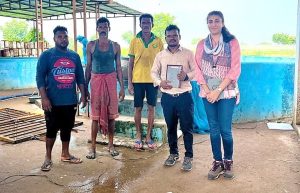 Field work with fisheries producers
Field work with fisheries producers
What awards or recognitions have come your way?
We are the World’s First ‘Whale’ Start Up for achieving a ‘Hockey-stick’ acceleration for solving hard-problems, fusing profits and impact in tandem with creating a better world; and we were awarded the Green Growth Startup UNEP Asia-Pacific Award. We were also recognized at IIGP 2.0, 3M Young Innovators and many of these accomplishments can be found on our website (https://naturedots.com/). NatureDots is a World Economic Forum’s and HCL Tech’s Global Top Innovator. We have been spearheading water causes on a global scale representing the concerns of water and fish farmers at the UN water conference, WEF-Davos, World Food Programme and FAO, Rome. As a torchbearer for water security and food-system resilience our efforts have been recognized and resonated across the globe.
As an entrepreneur what are your important learnings?
Firstly, it is important to not get too emotionally attached with the idea, and being open to share, listen and accept other people’s opinions for making your own idea stronger. Secondly, one should have the ability to take risks, but it should be a calculated risk. Thirdly, one should do a thorough assessment of user’s willingness to pay for services. Finally, one should not be afraid of sharing ideas with others thinking that it could be stolen. Sharing may help one to learn new ideas or form a team if someone has the same idea. It is a very big ecosystem where many such ideas are needed.
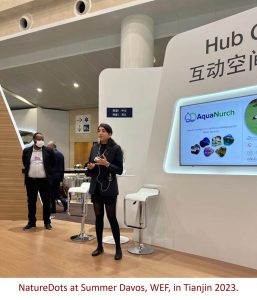 How gender responsive is NatureDots?
How gender responsive is NatureDots?
We have company policies of ensuring equal opportunity and gender sensitivity with a robust culture of cross-cultural exchange and sharing. You can find more from the job-posting section on our website dealing with our team hiring and culture policies.
Any specific challenges you faced as a women entrepreneur?
It was challenging initially for me as a woman to get into a male dominated field. But, once the farmers see that you know what you are talking about, they automatically respected me. Later, we progressed with testing our ideas/tools in the field, identified our farmers and engaged in actual business.
Safety and security are also another challenge during field visits by women colleagues or me. Finding a safe place to stay, mode of travel, etc., are important when planning our visits. These would differ from location to location.
During one of my fund-raising rounds, I faced some biased questions such as what is my age? am I married? when am I planning to get married? etc., which were not generally asked to my male co-founder. All those questions made me realise the hardships faced by a women entrepreneur, especially while raising funds.
Any specific learning as a ‘woman’ entrepreneur?
Yes, as a woman, one should not let any gendered or biased comments or actions affect you. As a first-generation woman entrepreneur, I can share that best learnings come from speaking and interacting with other women entrepreneurs so as to keep yourself abreast of how things should be handled, and to learn the tactics. Having a good cohort of people around who are supportive is important as an entrepreneur, and as a woman it becomes a game-changer. Such advisers and mentors help to boost one’s growth. There is no age limit for any woman to start her own business. It should be her choice when she wants to get married, have children and so on. Soft skills are very essential for women entrepreneurs. It is important to have a network of women entrepreneurs within which they can discuss their problems related to their journey, biases, etc., and get solutions to their problems.
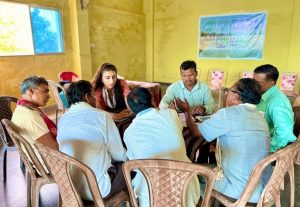 With commercial fisheries producers
With commercial fisheries producers
Any suggestions for policy actors?
Fisheries should be considered as a separate domain under policy and within that there should be distinction between different types – freshwater fishery, farm-based fishery, marine fishery, etc. There should be more centralised data available for fisheries sector to progress.
Any specific advice for upcoming women entrepreneurs?
Don’t be afraid of trying something new. One defining feature is that there is risk in everything. It is always good to try things out. Definitely, age should not be a bar. Being a woman entrepreneur is not easy. One needs to learn to handle difficult situations. To start with, it can be a lonely journey. Use any kind of network to get out and never get afraid to randomly try out solutions for your problems. Upskilling is super important, and it should never stop.
Acknowledgement: This interview was done as part of the IRRI-CRISP ongoing project ‘Mapping of Good Practices in Digital Innovations in India Supporting Women Agrientrepreneurs’.
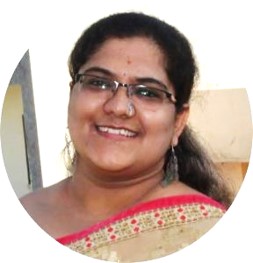 Bhuvana N, is a Consultant at the Centre for Research on Innovation and Science Policy (CRISP), Hyderabad. She has a PhD in Agricultural Extension, from Professor Jayashankar Telangana State Agricultural University, Hyderabad. Her research interests include organizational ecosystems and effectiveness, social networks and technological change. She can be reached at: bhuvanaditya7@gmail.com
Bhuvana N, is a Consultant at the Centre for Research on Innovation and Science Policy (CRISP), Hyderabad. She has a PhD in Agricultural Extension, from Professor Jayashankar Telangana State Agricultural University, Hyderabad. Her research interests include organizational ecosystems and effectiveness, social networks and technological change. She can be reached at: bhuvanaditya7@gmail.com
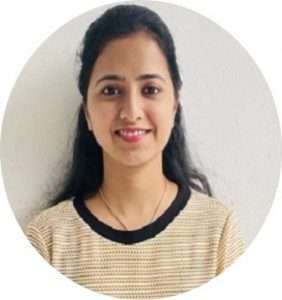 Sejal Agarwal, till recently worked as a Research Fellow at the Centre for Research on Innovation and Science Policy (CRISP), Hyderabad. She is presently working with Oorja Development Solutions Limited as Impact Manager She can be reached at sejal.iifm@gmail.com
Sejal Agarwal, till recently worked as a Research Fellow at the Centre for Research on Innovation and Science Policy (CRISP), Hyderabad. She is presently working with Oorja Development Solutions Limited as Impact Manager She can be reached at sejal.iifm@gmail.com
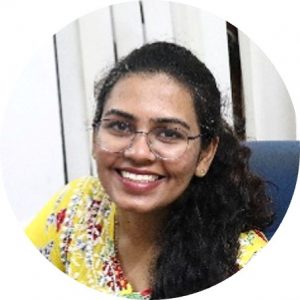 Ditty Maria Dominic, Research Fellow at Centre for Research on Innovation and Science Policy (CRISP), Hyderabad, Telangana, India. She can be reached at: ditty794@gmail.com
Ditty Maria Dominic, Research Fellow at Centre for Research on Innovation and Science Policy (CRISP), Hyderabad, Telangana, India. She can be reached at: ditty794@gmail.com

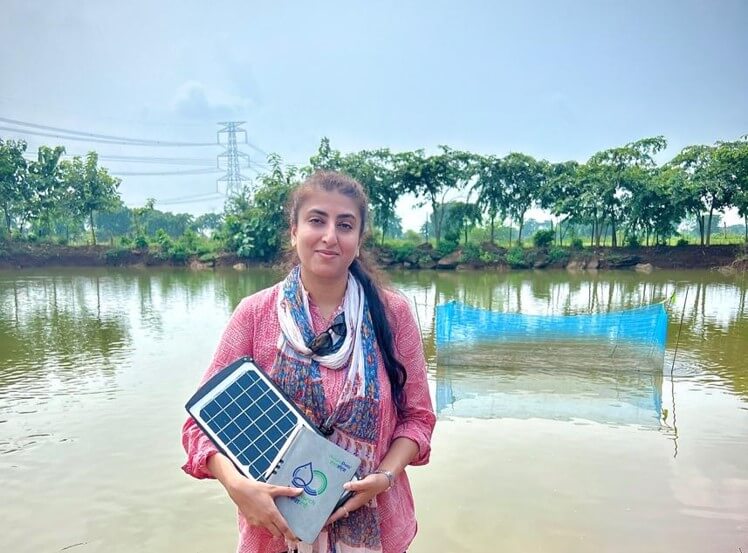

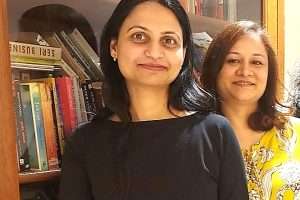

Outstanding digital science, innovations, education and commerce for welfare of fish farmers. Rising of an aquapreneur is amazing and the lessons for successful business venture through application of digital science is an eye opener for large scale follow up. The professional interview by the team is excellent in extracting all the needed insights of the journey for replication. Kudos to the enterprising women aquapreneur, team of highly professional interviewers and CRISP for sharing the success story with the public.